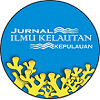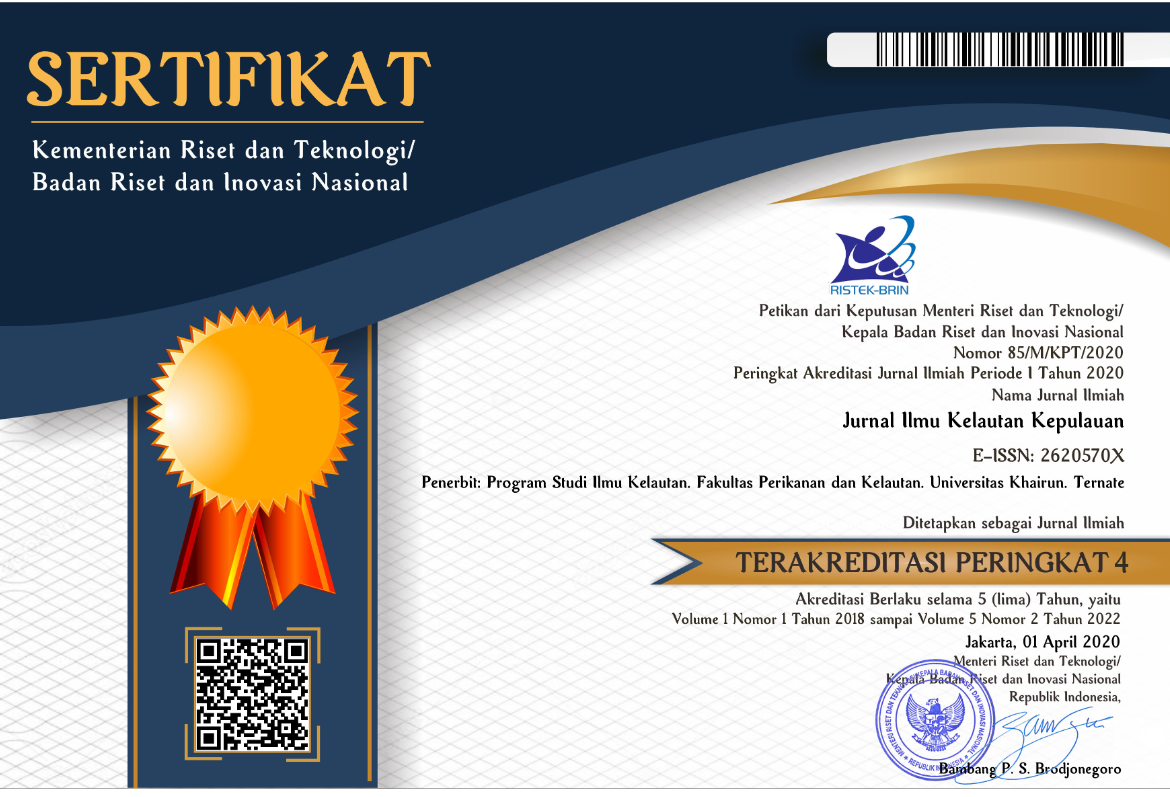Survei tingkat konsumsi ikan laut di Kalimantan Timur
Abstract
Marine fishes are one of the best nutrition sources for human. Data on the level of fish consumption still in form of total fish consumption, and data on marine fish consumption is still not presented properly. The purpose of this study was to determine the frequency of consumption of marine fish in several locations in East Kalimantan. Survey data were obtained from 348 respondents with an age range of 18 to 73 years from 10 districts and cities in East Kalimantan. This study based on survey method by filling out questionnaires via google forms were distributed to all respondents via android smartphones. The result come up with the highest frequency of fish consumption was 3 times a week. The type of fish most frequently consumed by respondents is mackerel (Rastrelliger spp.), maximum volume of fish consumed being <1/4 kg per consumption. Freshness of fish is one of the main factors that respondents consider when buying fish. The main body part was the favorite part consumed by responden then followed by the head part and tail part, while the most preferred cooking method is the fried method followed by grilling and boiling.
Keywords: Animals, City, Cooking, Smartphone, Human Body
Full Text:
668-677.Pdf (Bahasa Indonesia)References
Ahmad Hanis, H. I. A., Jinap, S., Mad Nasir, S., and Alias, R. 2013. Eliciting Malaysian consumer preferences for marine fish attributes by using conjoint analysis. World Applied Sciences Journal, 28(12): 2054–2060. https://doi.org/10.5829/idosi.wasj.2013.28.12.260.
Alp Erbay, E., and Yesilsu, A. F. 2021. Fish protein and its derivatives: functionality, biotechnology and health effects. Aquatic Food Studies, 01(01): 16–21. https://doi.org/10.4194/afs13.
Aziz, N. A., Ghazali, A., Yunus, K. Bin, Annual, Z. F., Ahmad, A., and Chuan, O. M. 2020. Longtail Tuna (Thunnus tonggol) conscumption frequency in Terengganu, Malaysia. Open Journal of Marine Science, 10(03): 141–148. https://doi.org/10.4236/ojms.2020.103011.
BPS (Badan Pusat Statistik) Kaltim. 2022. Propinsi Kalimantan Timur dalam angka. Badan Pusat Statistik Propinsi Kalimantan Timur, Samarinda. 753hal.
Claret, A., Guerrero, L., Aguirre, E., Rincón, L., Hernández, M. D., MartÃÂnez, I., Benito Peleteiro, J., Grau, A., and RodrÃÂguez-RodrÃÂguez, C. 2012. Consumer Preferences for Sea Fish Using Conjoint Analysis: Exploratory study of the importance of country of origin, obtaining method, storage conditions and purchasing price. Food Quality and Preference, 26(2): 259–266. https://doi.org/10.1016/j.foodqual.2012.05.006.
Depkes. 2009. Klasifikasi umur menurut kategori, Jakarta. 26hal.
EFSA. 2015. Statement on the benefits of fish/seafood consumption compared to the risks of methylmercury in fish/seafood. EFSA Journal, 13(1): 1–36.
Erdoǧan, B. E., Mol, S., and Coşansu, S. 2011. factors influencing the consumption of seafood in Istambul, Turkey. Turkish Journal of Fisheries and Aquatic Sciences, 11(4): 651–658. https://doi.org/10.4194/1303-2712-v11_4_18.
FAO. 2016. Strengthening sector policies for better food security and nutrition results. https://www.fao.org/3/i6227e/i6227e.pdf. (akses tanggal 14 Oktober 2022).
FAO. 2022. OECD-FAO Agricultural outlook 2022-2031. https://doi.org/https://doi.org/10.1787/f1b0b29c-en. (akses tanggal 14 Oktober 2022).
Gammone, M. A., Riccioni, G., Parrinello, G., and Orazio, N. D. 2019. Omega-3 polyunsaturated fatty acids : Benefits and endpoints in sport. Nutrients, 11(46): 1–16.
Geslani, C., Loke, M. K., Barnes-Mauthe, M., and Leung, P. S. 2015. Seafood purchasing preferences of hawaii chefs: Comparing actual purchase to stated preferences from conjoint choice experiment. Journal of International Food and Agribusiness Marketing, 27(1): 50–63. https://doi.org/10.1080/08974438.2013.833569.
Hicks, C. C., Cohen, P. J., Graham, N. A. J. J., Nash, K. L., Allison, E. H., D’Lima, C., Mills, D. J., Roscher, M., Thilsted, S. H., Thorne-Lyman, A. L., and MacNeil, M. A. 2019. Harnessing global fisheries to tackle micronutrient deficiencies. Nature, 574(7776): 95–98.
Kaltimprov. 2022. Data konsumsi ikan propinsi Kaltim tahun 2016-2021. https://kkp.go.id/setjen/satudata/page/1453-kelautan-dan-perikanan-dalam-angka. (akses tanggal 15 Oktober 2022).
KKP. 2018. Potensi usaha dan peluang investasi kelautan dan perikanan propinsi Kalimantan Timur. https://kkp.go.id/an-component/media/upload-gambar-pendukung/A_PDS/Potensi Usaha dan Investasi/Kaltim.pdf. (akses tanggal 15 Oktober 2022).
Lapi, I., Kolliniati, O., Aspevik, T., Deiktakis, E. E., Axarlis, K., Daskalaki, M. G., Dermitzaki, E., Tzardi, M., Kampranis, S. C., and Marsni, Z. El. 2021. Collagen containing fish sidestream derived protein hydrolysates support skin repair via chemokine induction. Marine Drugs, 19(7): 396. https://doi.org/10.3390/md19070396.
Maciel, E. da S., Savay-Da-Silva, L. K., Vasconcelos, J. S., Sonati, J. G., Galvão, J. A., de Lima, L. K. F., and Oetterer, M. 2013. Relationship between the price of fish and its quality attributes: A study within a community at the University of São Paulo, Brazil. Food Science and Technology, 33(3): 451–456. https://doi.org/10.1590/S0101-20612013005000059.
Mansoor, O., and Jenkin, G. 2007. Cheaper than chicken: Protein foods ranked by supermarket prices. Journal of the American Dental Association (1939), 120(1259): 1–4. https://doi.org/10.14219/jada.archive.1980.0221.
Mar’ie, M., Saifullah, dan Istiqamah, N. 2022. Faktor-faktor yang mempengaruhi tingkat konsumsi ikan pada masyarakat di Kecamatan Sajad. NEKTON: Jurnal Perikanan Dan Ilmu Kelautan, 2(1): 27–34. https://doi.org/10.47767/nekton.v2i1.323.
Mendivil, C. O. 2021. Fish consumption: A review of its effects on metabolic and hormonal health. Nutrition and Metabolic Insights, 14(1): 1–6.
Mohanty, N., and Nayak, L. 2018. Proximate composition of fishes comprising of three families aridae, scrombidae, and stromatidae collected from Gopalpur coast, East of India. International Journal of Science Inventions Today, 7(1): 108–118.
Nurmawati, Harahap, R. G., dan Wulandari, A. I. 2019. Gemarikan warga kelurahan manggar baru, balikpapan timur : Konsumsi ikan kekinian melalui inovasi produk olahan ikan. SEPAKAT 2019, 1(1): 1–6.
Nurul Makiyah, R., Fitriyana, dan Asman, Z. 2017. Kecenderungan konsumen dalam memilih jenis ikan di restoran Dwi Madiun Kelurahan Gunung Samarinda Kota Balikpapan Propinsi Kalimantan Timur. Jurnal Pembangunan Perikanan Dan Agrobisnis, 4(2): 55–61.
Obiero, K., Meulenbroek, P., Drexler, S., Dagne, A., Akoll, P., Odong, R., Kaunda-Arara, B., and Waidbacher, H. 2019. The contribution of fish to food and nutrition security in Eastern Africa: Emerging trends and future outlooks. Sustainability (Switzerland), 11(6): 1–15. https://doi.org/10.3390/su11061636.
Pemprov Kaltim. 2018. Laporan penyusunan pemetaan potensi investasi perikanan dan kelautan propinsi Kalimantan Timur, Samarinda. 76hal.
Pratisti, C. 2017. Model konsumsi ikan pada konsumen muda. Jurnal Riset Ekonomi Manajemen (REKOMEN), 1(1): 1–15. https://doi.org/10.31002/rn.v1i1.556.
Pro Balikpapan. 2017. Ikan Kembung Goreng Sambal Hijau. Balikpapan Pos, 23 Juli 2017.
Saka, F., and Bulut, M. 2020. Determination of fish consumption in Çanakkale. Marine Science and Technology Bulletin, 9(1): 7–14. https://doi.org/10.33714/masteb.658093.
Sari, R. P., and Muflikhati, I. 2018. The influence of mother’s motivation and preferences toward fish consumption behavior of family in rural and urban areas. Journal of Consumer Sciences, 3(1): 39–49.
Suhaimi, A. 2012. Ketahanan pangan berbasis sumberdaya lokal: Konsumsi pangan dan status gizi pada penduduk asli di wilayah bantaran sungai dan non bantaran sungai, Kalimantan Timur. Rawa Sains : Jurnal Sains Stiper Amuntai, 2(2): 37–45. https://doi.org/10.36589/rs.v2i2.14.
Tilami, S. K., and Sampels, S. 2018. Nutritional value of fish: Lipids, proteins, vitamins, and minerals. Reviews in Fisheries Science & Aquaculture, 26(2): 243–253.
Virgantari, F., Koeshendrajana, S., Arthatiani, F. Y., Faridhan, Y. E., dan Wihartiko, F. D. 2022. Pemetaan tingkat konsumsi ikan dalam rumah tangga di Indonesia. Jurnal Sosial Ekonomi Kelautan Dan Perikanan, 17(1): 97–104
DOI: https://doi.org/10.33387/jikk.v5i2.5599
Refbacks
- There are currently no refbacks.
Â
Â
Â
 | Address : Marine Science Study Program, Faculty of Fisheries and Marine Science - Khairun University, Ternate, North Maluku, Indonesia |






